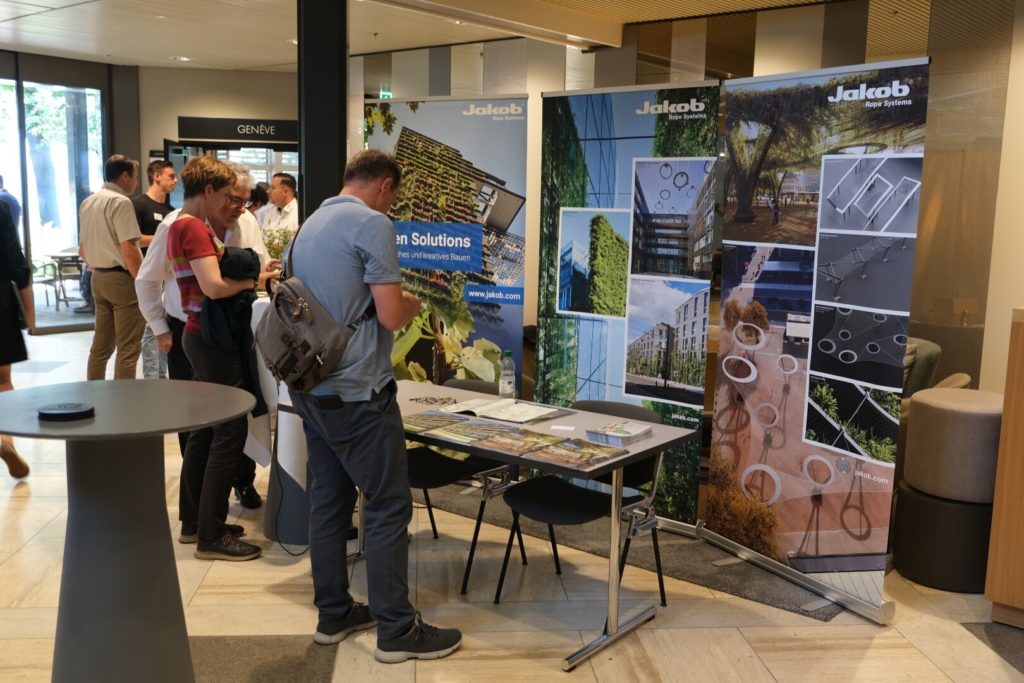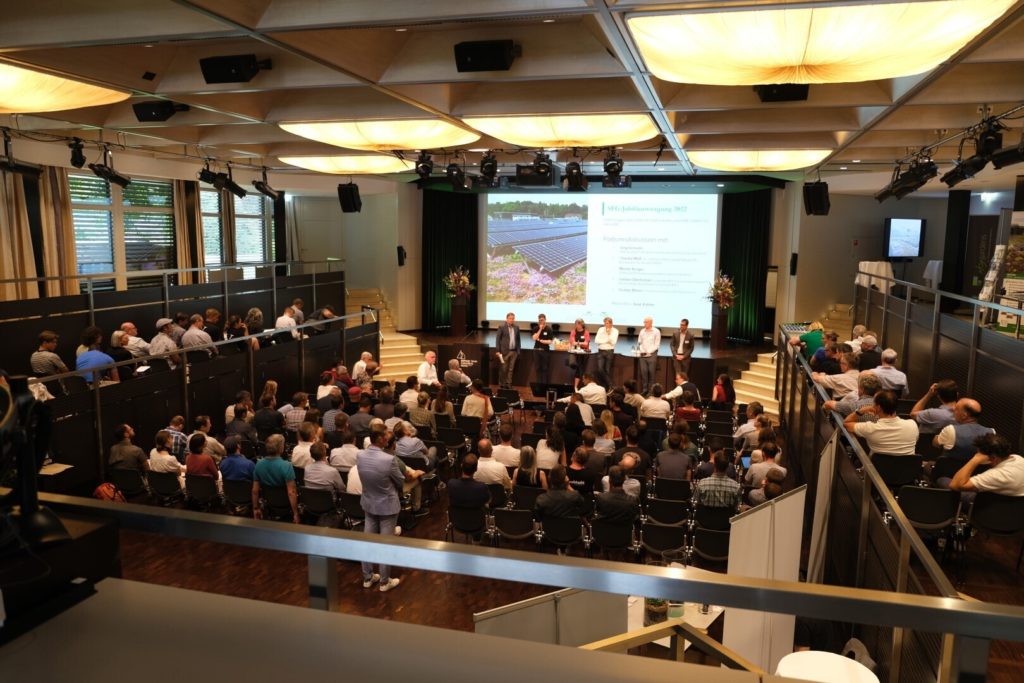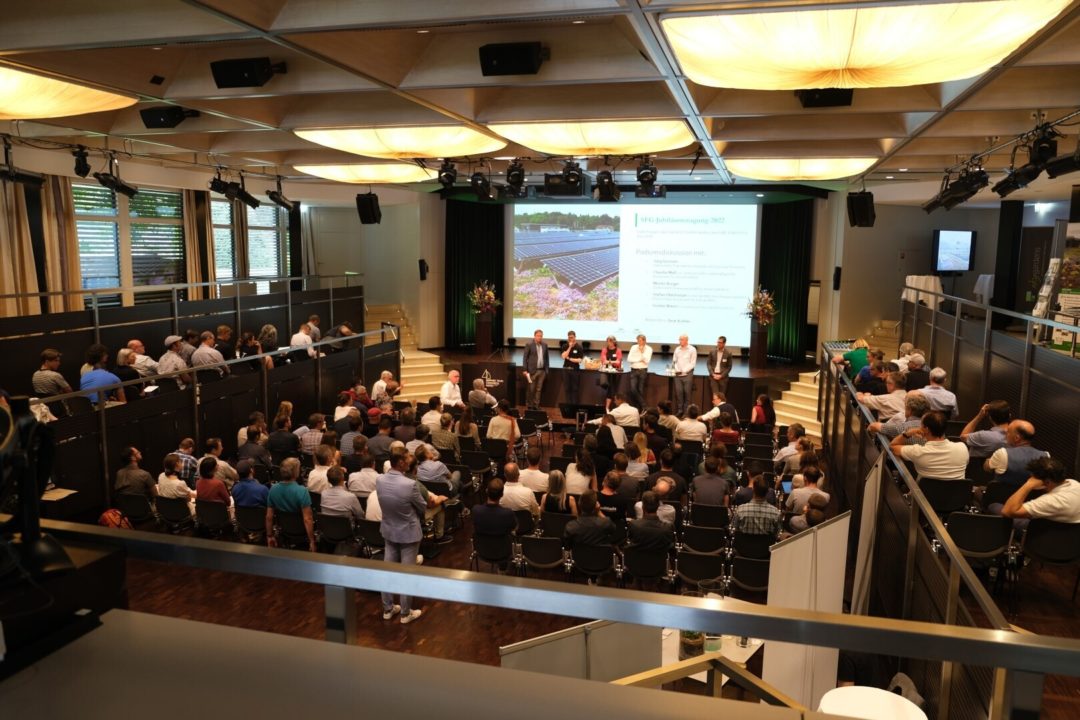Greening buildings: SFG promotes the “Solar Green Roof”
On 22 June 2022, the Swiss Greening Association celebrated its 25th anniversary in Thun. Building Greening SFG” celebrated its 25th anniversary in Thun – its founding location – with an anniversary and trade event. A total of 160 people experienced a worthy anniversary conference on the exciting topic of “The green city of the future”.
The greening of buildings has a long tradition in Switzerland. With the spread of flat-roof architecture, there has also been a need to green such roofs and to make them more attractive and to produce them in good quality. This led to the founding of the SFG in 1995. Even at that time, one of the main purposes of the association was to provide a qualitative framework for the greening of buildings, and in particular for greened flat roofs. A first milestone was set with the guideline for extensive green roofs, which appeared in 1999. The commitment of the professional association subsequently aimed to establish the concept of quality and the understanding of sustainable green roofs, to sensitise planners and implementers to this and to train them. The SFG participated in the development of the corresponding SIA standard. In addition, it developed and maintained contacts and relationships with professional associations – including Jardin Suisse and Gebäudehülle Schweiz – as well as at the international level. In the course of all these activities, the SFG eventually gained broad recognition. Various presidents and members have served the professional association as board members with great commitment over the years, and the members have supported the association and strengthened it with their trust. Thanks to them, the SFG can celebrate its 25th anniversary.
More green in urban areas
The increased number of annual heat days and heavier rainfall are tangible indications of climatic changes. In Bern, for example, the average annual temperature has risen by 1.7 °C since the 1990s and continues to show an upward trend. The preservation and expansion of green spaces and plantings with their cooling, storage, protection and biodiversity effects can contribute to the mitigation and dampening of weather extremes. Urban greenery counts!
Electricity and green: can they go together?
Speaker National Councillor Jürg Grossen is convinced: “In the context of the national energy transition, solar energy will become the mainstay of Switzerland’s energy supply. “This requires space – on and around buildings – space that is also occupied by the greenery of buildings. In practice, a conflict often arises here: electricity versus greenery. Existing green roofs are “eliminated” and then covered with solar energy. “In contrast, there are proven, efficient solutions that demonstrate a consensus – for example, the energy green roof promoted by SFG, which effectively combines solar electricity production and biodiverse greenery biodiverse greenery:
- Raised solar panel rows are at least 35 cm above low-growing vegetation with a row spacing of at least 60 cm for maintenance and care.
- Or bifacially usable modules are perpendicular to the roof surface at the required row spacing (shadow cast by the modules).
of the modules), which enables high production when the sun is flat.
Insgesamt 14 Referentinnen und Referenten boten aufschlussreiche Informationen zu den Schwerpunkten ihrer beruflichen Tätigkeit. Den Teilnehmenden ermöglichte das vielseitige, spannende Programm eine wertvolle Übersicht zum Tagungsthema. Und neben den Präsentationen blieb auch Zeit zum persönlichen Austausch und Kontakt an den Ständen der Aussteller. Den Vortragenden sei an dieser Stelle ganz herzlich gedankt: Conrad Amber, Daniel Bärtschi, Nathalie Baumann, Moritz Burger, Nicolas Disch, Anke Domschky, Dusty Gedge, Jürg Grossen, Stefan Herfort, Hanspeter Latour, Claudia Moll, Stefan Oberholzer, Erich Steiner und Martin Vinzenz. Einige Eindrücke oder Erkenntnisse aus den Präsentationen seien hier herausgegriffen:
- On the value of a tree: a 100-year-old beech has 600,000 leaves, 1500 m2 of leaf surface, absorbs 6 t of CO2 and 1 t of particulate matter annually. 1 t of particulate matter, produces 4.5 t of oxygen per year, evaporates up to 400 litres of water per day and litres of water per day and acts as a groundwater regulator. To replace this beech the planting of 2000 new trees with a of 2000 trees with a crown volume of 1.5 m3.
required, at a cost of 150,000 euros. - We live in a dangerous age. Man dominates nature before he has
he has learned to control himself. (Albert Schweitzer) - Influence of climate change on Swiss Swiss cities: heavy precipitation, heat extremes, drought and lack of snow.
- City of Lucerne: urban planning and architectural reservations about
raised solar installations. Biodiversity: we can only manage it together
(Hanspeter Latour) - FOEN, mandate in agglomeration areas: including the promotion of biodiversity, safeguarding green spaces secure green spaces, network habitats, Preserve settlement-specific species SFOE, photovoltaic potential of Swiss buildings Buildings: 50 TWh/a on roofs, 17 TWh/a on façades, current Total energy consumption of the country:
207 TWh/a. - Spatial planning Switzerland, challenges: soon to be 10 million inhabitants, traffic, scarce resources, location competition, food security, soil and climate – net zero, building in the existing stock
(70 % of real estate needs energy energy renovation), environmental degradation, sufficiency and resilience.
Outlook
The future presents us all with new and and greater challenges. In this respect SFG stands on a stable foundation. Cooperation with partners,
mutual trust, and a commitment of the association in the service of the
in the service of the cause will allow the SFG to take on and meet the challenges of the future challenges and to cope with them and overcome.


(c) SFG

